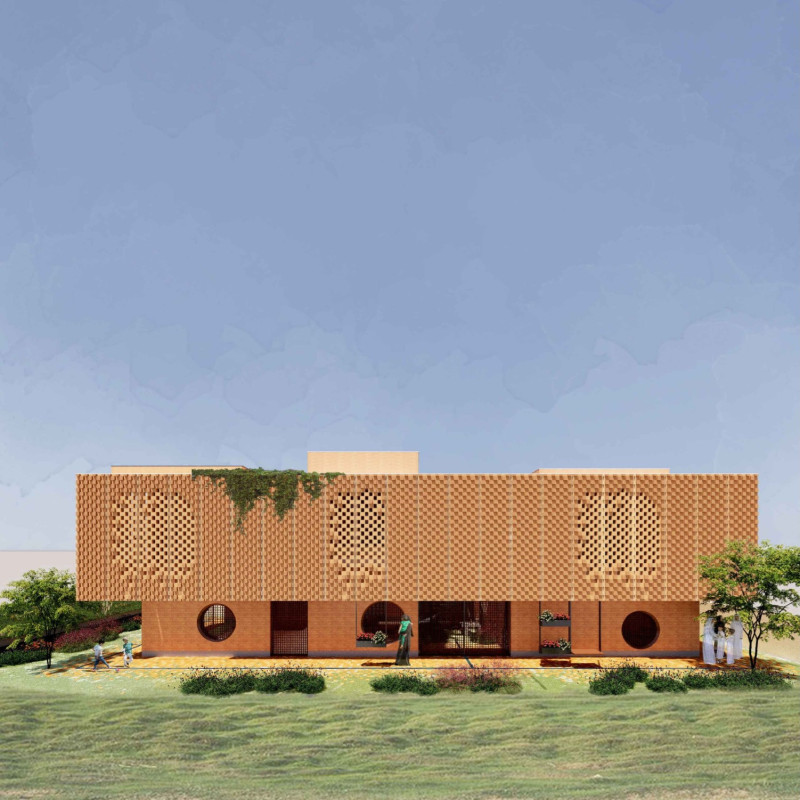5 key facts about this project
The core purpose of this architectural endeavor is to serve as a multifunctional space that meets diverse user needs while pushing the boundaries of conventional design. This functionality is articulated through an array of spaces, each thoughtfully designed for specific activities. The design effectively incorporates both communal and private areas, catering to communal gatherings and individual pursuits alike. The design's flexibility is underscored by the versatile use of interiors that can adapt to varied programming requirements.
One of the notable aspects of the project is its materiality, which plays a crucial role in the overarching aesthetic and functional narrative. The careful selection of materials not only enhances the visual appeal but also resonates with environmental sustainability principles. Materials such as reclaimed wood, glass, and locally sourced stone are predominant throughout the design, establishing a tactile connection to the surrounding landscape while promoting ecological responsibility. The use of natural light is optimized through large windows and strategically placed skylights, fostering a connection between the indoor environment and the natural world outside. This approach not only reduces energy consumption but also elevates the occupants' experience by creating a sense of openness and tranquility.
The architectural design is remarkable for its expression of geometric clarity and simplicity. The lines are clean and purposeful, with a rhythmic interplay of solid and void that creates a dynamic visual language. The façade, characterized by a harmonious composition of textures and tones, invites dialogue between the structure and its environment, establishing a subtle contrast yet maintaining an inviting charm. The integration of outdoor spaces further enhances the project’s appeal, creating seamless transitions between in- and outdoor areas that encourage interaction and engagement with nature.
A unique design approach evident in this project is the emphasis on biophilic design principles, which seek to enhance the relationship between people and nature. This is accomplished through the incorporation of green roofs, living walls, and native plant landscaping, all of which not only beautify the space but also contribute to environmental health. The integration of nature into the architectural framework promotes well-being and supports biodiversity, illustrating a forward-thinking perspective that values ecological balance.
In addition to its aesthetic elements and functional spaces, the project also addresses the socio-cultural context of its location. It reflects an understanding of local traditions and historical narratives that inform architectural language, creating a sense of place that resonates with the community. The project's engagement with local artisans in the selection of materials and finishes further underscores its commitment to community integration and cultural sensitivity.
The exploration of architectural plans reveals the thoughtful consideration given to circulation and spatial relationships within the design. Flow patterns are intuitive, guiding occupants through the various spaces while maintaining an overarching sense of coherence. This careful orchestration of movement enhances the user experience, promoting ease of access and interaction across the different functional zones.
As one delves deeper into the architectural sections, it becomes evident that vertical circulation plays a vital role in the overall experience of the space. The incorporation of staircases as focal points not only facilitates movement but also serves as design elements that enhance the aesthetic narrative. The exploration of these architectural details illuminates the overarching vision that informs the project, showcasing the meticulous attention to both form and function.
The design outcomes demonstrate a comprehensive understanding of contemporary architectural practices, as well as a commitment to sustainability and community engagement. The project stands as a testament to the principles of responsive architecture that prioritize the needs of users while fostering a respect for the natural environment.
Readers interested in exploring the nuances of this architectural project are encouraged to examine the architectural plans and sections for further insights into the design decisions that shape this exceptional work. By engaging with the details of architectural designs and ideas presented, one can gain a fuller appreciation of the thought processes and methodologies at the heart of this innovative architectural endeavor.


























